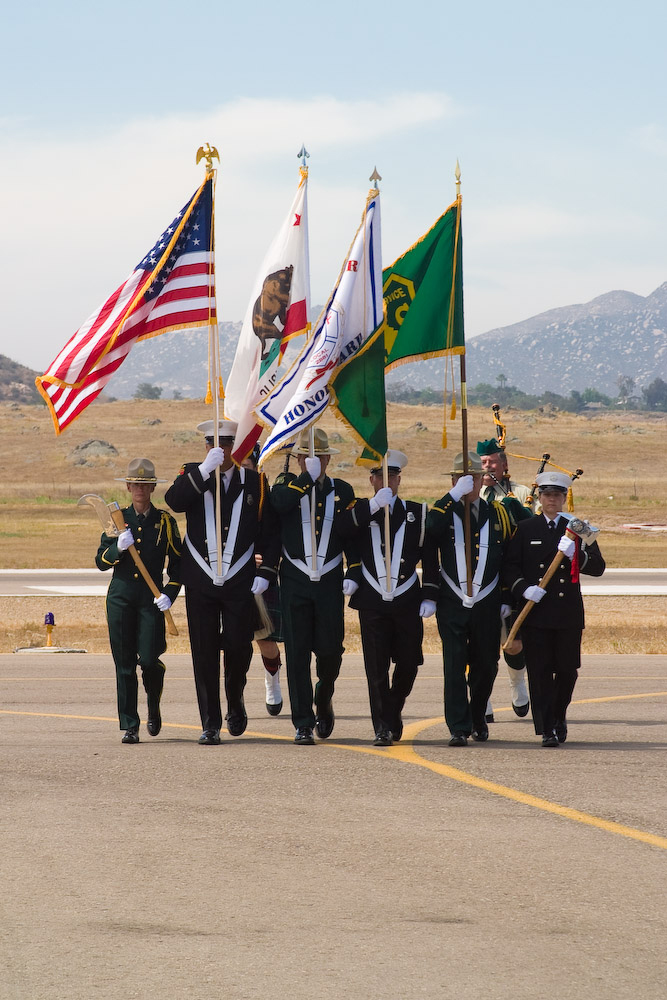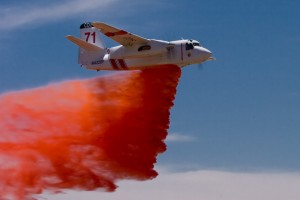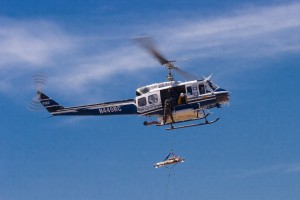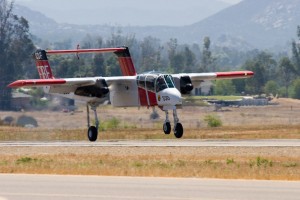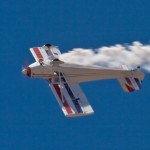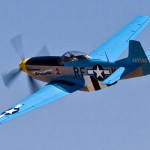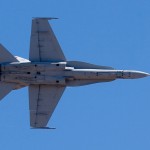By John Wright
The annual Ramona Air Show was held at the Ramona Airport on June 23 and 24. The California Department of Forestry and Fire Protection used the air show to celebrate the 50th anniversary of the Ramona Air Attack Base, located at the airport.
The base, established in 1957, operates in cooperation with the United States Forest Service. It’s the oldest permanent aerial firefighting base in the U.S. and one of the most active. Firefighting aircraft flying from the base include two Grumman S-2F3T Tracker aerial tankers, a North American (Rockwell) OV-10A Bronco air tactical aircraft and a Bell 212 Helitack helicopter.
Marsh Aviation of Mesa, Ariz., converted the Navy surplus S-2F aircraft for firefighting. The conversion included replacing the original radial piston engines with turbine engines and lengthening the fuselage for increased retardant capacity.
The Marine Corps surplus OV-10A Bronco is used as a command and control aircraft, with the crew of the pilot and an air tactical group supervisor.
The Forest Service flies the Bell 212 helicopter from Ramona as well. This multipurpose helicopter transports “helitack” hand crews to cut brush and fight fires. Sporting a 350-gallon tank, the aircraft also works in conjunction with the OV-10 and can drop both water and fire retarding foam.
Speakers at the opening ceremonies included Kate Dargan, the California State fire marshal; Thomas Gillet, USFS, the acting Cleveland National Forest supervisor; Diane Jacob, San Diego County second district supervisor; and Karen Sears, president of the Associated Air Tanker Pilots Memorial Trust Fund. Jacob presented a proclamation to Dargan, proclaiming June 23, 2007, to be “Ramona Air Attack Base Day” throughout San Diego County.
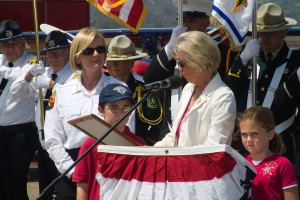
San Diego County Supervisor Diane Jacob (right) presents a proclamation to Kate Dargan, California State fire marshal, declaring June 23, 2007 “Ramona Air Attack Base Day.”
The CDF air tankers and the OV-10A Bronco opened the air show, performing a flyby and a missing man formation in honor of fallen firefighters everywhere. The San Diego County Sheriff’s Department conducted a search and rescue demonstration with their Bell 205A1++ helicopter, rescuing a “victim” from an area adjacent to the runway. This helicopter is one of two refurbished Bell Super Huey firefighting helicopters purchased for the new regional fire helicopter program the county started after the October 2003 wildfires. Both are single-engine, medium-lift helicopters, equipped with 375-gallon, underbelly water tanks.
After the sheriff’s demonstration, the Cal Fire tankers taxied out and took off for a number of flybys and an impressive demonstration of fire retardant drops. These red, white and blue drops kept with the theme of honoring fallen firefighters.
Jacquie “Jacquie Baby” Warda, the first civilian performer on Saturday, flew in her 1986 Pitts S-1T biplane, Red Eagle. Her plane was one of three Pitts to fly around the Statue of Liberty in 1986 upon the completion of the statue’s refurbishing. Warda put on a great aerobatic performance, highlighting the capabilities of the biplane.
John Collver, in his North American SNJ-5 Texan, War Dog, and Chuck Hall, in his P-51D Mustang, Six Shooter, turned in their usual excellent performances. Both Collver and Hall are regular performers on the Southern California air show circuit.
Other aerobatic performers included Frank “Dr. D” Donnelly in his modified 1946 Taylorcraft “T-Cart” and Canadian Aerobatic Team member Doug Jardine in his Sukhoi SU-26 MX.
Donnelly performs a different style of aerobatics than most performers. He performs his maneuvers more leisurely, without the abrupt movements of other aerobatic aircraft. His signature move is an engine-off loop and roll, followed with an engine-off landing. His Taylorcraft boasts a Swick conversion to improve aerobatic performance. The plane has clipped wings, only one seat, larger control surfaces and a 125-hp Lycoming engine in place of the standard 65-hp Continental.
Jardine’s SU-26MX is the high-performance version of the Russian-built Sukhoi 26 series, the first Soviet production aircraft delivered to the U.S. Its 360-hp radial engine, three-bladed, 104-inch diameter propeller and use of advanced composite construction allow Jardine to perform the most extreme aerobatic maneuvers.
The Red Stars Team performed a demonstration of precision formation flying in their Russian-built Yak-52s. The team is comprised of more than 100 civilian and ex-military aviators nationwide, dedicated to promoting the restoration and preservation of ex-Eastern Bloc aircraft and inspiring youth to careers in aviation. They also honor veterans by flying the fruits of the Cold War victory.
The Silver Wings Wingwalking Team, Margaret “Margi” Stivers and pilot Hartley Folstad, performed their third air show since Stivers’ return from knee surgery. Always a crowd-pleaser, Stivers was particularly popular with the youth. She capped her flawless routine with a flyby, displaying the U.S. flag as a tribute to its troops and veterans. After signing autographs, she allowed several young spectators to climb to the upper wing of the Stearman biplane used in her performance.
The highlight of the show was pilot Lt. Adam “Hander” Stieve’s demonstration of the Navy’s F/A-18C fighter. The West Coast demonstration team from Strike Fighter Squadron 125, the “Rough Raiders,” based at Naval Air Station Lemoore, brought two aircraft to the show. Stieve demonstrated high and low speed maneuvers, including a vertical climb and a “high-alpha” pass.
Over the two days of the show, activities halted several times as CDF and USFS aircraft dispatched to answer fire calls in the Southern California area. On one occasion, the tankers made a water drop over the airport to empty their tanks. They landed and were hot-loaded with retardant prior to departing.
A diverse mix of aircraft was on static display at the show. Classic Rotors, based at Ramona, displayed its Piasecki H-21 Shawnee “Flying Banana,” a fully restored Aérospatiale Alouette II and a Hiller H-32 Hornet. The H-32 is unique in that two ramjets on the rotor tips, weighing 40 pounds apiece, power the rotor. Also on display were a mint Cessna 195, a pair of Sukhoi SU-29s, a two-seat version of the SU-26 and a beautifully painted Aero Vodochody L-39 Albatross, piloted by Brian Shaul. The Navy brought two Beech Aircraft T-34 Turbo Mentors, which are used as primary flight trainers for Navy and Marine Corps pilots.
For more information about the Ramona Air Show, visit [http://www.ramonaairshow.com].
- Jacquie Warda performed in her 1986 Pitts S-1T biplane, Red Eagle. Her plane was one of three Pitts to fly around the Statue of Liberty in 1986 upon the completion of the statue’s refurbishing.
- Jacquie Warda signs autographs for the crowd.
- Aerobatic performers included Canadian Aerobatic Team member Doug Jardine in his Sukhoi SU-26 MX.
- Doug Jardine performs extreme aerobatic maneuvers in his SU-26 MX.
- The Silver Wings Wingwalking Team salutes troops and veterans.
- Frank “Dr. D” Donnelly inverts in the 1946 Taylorcraft “T-Cart.”
- Chuck Hall, in his P-51D Mustang, Six Shooter, gave an excellent performance.
- Margi Stivers shows the ropes to future wing-walking performer Sarah Bedford.
- Demonstration pilot Lt. Adam “Handers” Stieve showed the crowd what the F/A-18C can do.
- Lt. Adam “Handers” Stieve pulls Gs and shows the underside of the F/A-18.











